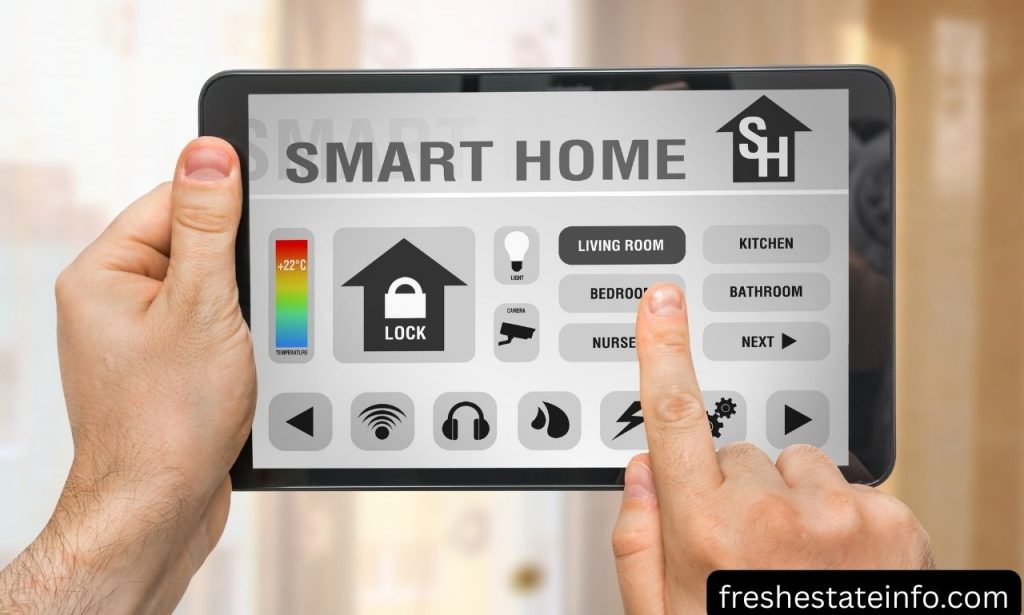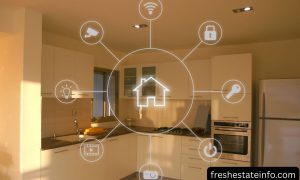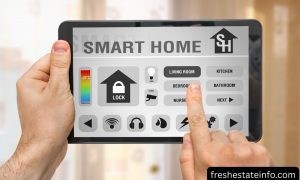My dad once called me in a panic about his new smart speaker. “It keeps ordering stuff I didn’t ask for!” It turns out he’d placed it next to the TV. Every time a commercial mentioned something, his device happily added it to his cart. We laughed about it later, but it taught me something crucial: Smart homes need thoughtful planning.
Today’s technology lets us control almost everything with our voices or phones. The lights turn on when you enter a room, coffee starts brewing before your alarm goes off, and the front door locks itself when you leave. Yet jumping into smart home design without a plan creates headaches and is inconvenient.
This guide walks you through the basics of smart home technology. You’ll learn which gadgets offer real value and how to avoid costly mistakes. Let’s create a home that works for you, not against you.
What Is A Smart Home?

A smart home connects everyday devices to a network you control. These devices communicate with each other and with you. They respond to schedules, voice commands, or conditions you set up.
Think of your house as a body and smart devices as its nervous system. Your phone or voice assistant acts as the brain. Each part works together to make life easier.
Smart homes vary widely in complexity. Some people start with just a smart speaker and a few lights. Others automate everything from blinds to bathroom fans. The beauty lies in customizing your setup to your actual needs.
Technology is constantly advancing in this space. Today’s systems offer more reliability and easier setup than ever before, and integration between different brands continues to improve.
What Are the Benefits of Having a Smart Home?
Smart homes deliver convenience that feels almost magical at times. Imagine walking into your house with full hands. The lights turn on automatically as you enter, and your favorite music starts playing without pushing a button.
Smart home technology dramatically improves security. You’ll know instantly if someone approaches your door, and camera feeds show you exactly who’s there, even when you’re miles away.
Energy savings often surprise new smart home owners. Heating and cooling adjust automatically when nobody’s home. Lights turn off in empty rooms without any effort on your part.
Accessibility represents another major benefit worth considering. Voice control helps people with mobility challenges, and automated routines eliminate steps that might be difficult for some family members.
Property values typically increase with well-designed smart home systems. Buyers increasingly expect these features in modern homes. Your investment pays dividends if you eventually sell.
The peace of mind factor shouldn’t be underestimated either. Checking that doors are locked from anywhere feels reassuring. Seeing all is well at home while traveling reduces stress considerably.
What Are the Key Components of a Smart Home?
The heart of most smart homes is a central hub or voice assistant. Products like Amazon Echo, Google Nest, or Apple HomePod serve this purpose well. They interpret your commands and coordinate your devices.
Reliable Wi-Fi forms the foundation of any functional smart home. Without strong signals throughout your house, connected devices may fail. Mesh networks help eliminate dead spots in larger homes.
Smartphones or tablets provide the control interface you’ll use most often. Apps let you adjust settings from anywhere with internet access, so your phone essentially becomes a universal remote for your entire house.
Sensors play a crucial role in automation. Motion detectors, door sensors, and temperature monitors constantly gather information, which helps the system make decisions without your input.
Actuators transform digital commands into physical actions. Smart switches, motorized blinds, and electronic locks fall into this category. They execute the changes you or your automated routines request.
Compatibility between devices matters more than most beginners realize. Look for products supporting major standards like Wi-Fi, Zigbee, or Z-Wave. This ensures that everything can talk to each other effectively.
Essential Devices for Your Smart Home
Security – Most Important Component of a Smart Home
Home security provides the perfect entry point for smart home beginners. These devices offer immediate value and peace of mind. Many homeowners report security as their primary motivation for getting started.
Modern smart security systems work even during power outages. Battery backups and cellular connections maintain protection when you need it most. Many systems send alerts directly to your phone if anything seems wrong.
Professional monitoring remains optional with most smart security setups. You can self-monitor through your phone or add professional services. This flexibility helps keep costs reasonable for every budget.
Installation has become remarkably simple compared to traditional alarm systems. Many components connect wirelessly and attach with adhesive strips. In most cases, drilling holes or running wires through walls is not necessary.
Smart Locks
Smart locks eliminate the hassle of physical keys entirely. Family members each get their own code or use their phones instead. You’ll never wonder if you forgot to lock up again.
With these advanced locks, temporary access becomes simple. Create codes for dog walkers or house guests who work only during specific hours. Delete access instantly when it’s no longer needed.
Many smart locks keep detailed logs of who enters and exits. This feature proves invaluable for families with teenagers or rental properties. You’ll know exactly who came home and when.
Installation typically takes less than 30 minutes with basic tools. Most models replace just the interior portion of your existing deadbolt. Your original key will still work if battery power ever fails.
Smart Doorbell is a Video Doorbell
Smart doorbells let you answer the door from anywhere with internet access. The delivery person doesn’t need to know you’re actually at work. Two-way communication works through your phone.
These devices record video whenever someone approaches your door. The footage saves automatically to the cloud for later review. Some models recognize familiar faces and announce visitors by name.
Motion detection alerts you to activity even if someone doesn’t ring the bell. This feature catches package thieves before they strike, and many homeowners report feeling safer with this extra awareness.
Most models install using existing doorbell wiring for continuous power. Battery-powered options work great for renters or homes without doorbell wiring. Installation typically takes less than an hour either way.
How To Integrate Smart Lighting Into Your Home
Smart lighting transforms the atmosphere and functionality of any space. Simple voice commands can adjust brightness, color, or turn lights on and off. The convenience factor alone justifies the investment for many homeowners.
Energy savings accumulate quickly with automated lighting. Lights turn off automatically in empty rooms or when you leave home, and scheduling ensures outdoor lights run only during appropriate hours.
Setting scenes creates one-touch control for different activities. “Movie night” might dim the living room and turn off hallway lights. “Good morning” could gradually brighten bedroom lights to wake you naturally.
Smart lighting supports both retrofitting and new construction equally well. You can start with just a few key fixtures and expand over time. This gradual approach helps manage costs effectively.
Smart Light Switches
Smart switches offer better reliability than individual smart bulbs. One switch controls all the lights on that circuit. This approach works well for fixtures with multiple bulbs.
Installation requires basic electrical knowledge or a professional electrician. Most switches need a neutral wire which older homes sometimes lack. Always verify compatibility before purchasing.
Voice control works seamlessly with properly installed smart switches. “Turn on the kitchen lights” becomes the new normal. Physical buttons remain functional for guests unfamiliar with voice commands.
Scheduling options make your home look occupied even when you’re away. Lights turn on and off in natural patterns throughout the evening. This simple security measure deters potential break-ins effectively.
Smart Systems To Measure And Control Your Energy Consumption
Energy management represents a major win for smart home enthusiasts. These systems identify waste and help optimize usage patterns. Many users report 10-30% savings on utility bills.
Real-time monitoring shows exactly which devices consume the most power. This information helps prioritize upgrades or behavior changes. The payback period on these systems often surprises homeowners.
Smart Thermostat
Smart thermostats learn your schedule and preferences automatically. They adjust temperatures to save energy when nobody’s home. Comfort returns before you walk through the door.
Installation typically takes about 30 minutes for those comfortable with basic wiring. Compatibility checks matter before purchasing any model. Not all heating and cooling systems work with every smart thermostat.
Remote adjustment through smartphone apps proves incredibly convenient. Heading home early? Warm up the house from your phone. Staying late at work? Delay the heat until later.
Some utility companies offer rebates for installing qualified smart thermostats. These incentives sometimes cover half the purchase price or more. Check with local providers before buying.
Smart Breakers
Smart breakers monitor electricity usage at the circuit level. They identify energy hogs you might otherwise miss. Some can even shut off power remotely if needed.
Installation requires professional help in most cases. These devices replace standard breakers in your electrical panel. Always prioritize safety when dealing with electrical systems.
Power consumption data appears in easy-to-understand graphs on your phone. You’ll see exactly when and where electricity gets used. This visibility often leads to better habits naturally.
Some models detect potential fire hazards before they become dangerous. Unusual patterns might indicate faulty wiring or failing appliances. Early warnings potentially prevent serious damage.
Smart Cooktops
Smart cooktops bring safety and precision to meal preparation. Temperature controls maintain exact heat levels for perfect results. Timers shut off burners automatically to prevent accidents.
Remote monitoring lets you check if you left the stove on from anywhere. This feature alone provides tremendous peace of mind. No more turning the car around to double-check.
Voice control allows hands-free operation while cooking messy dishes. “Set burner two to medium heat” works even with flour-covered hands. This convenience makes cooking more enjoyable.
Integration with recipe apps streamlines the cooking process significantly. Temperature and timing adjust automatically for each step, making even complex dishes more approachable.
What’s The First Step In Building Your Smart Home
Make a List of Needs and Wants for Your Smart Home
Start your smart home journey by identifying genuine problems technology might solve. Does your family forget to lock doors? Do lights stay on in empty rooms? Address real pain points first.
Consider the daily routines that could benefit from automation. Morning coffee, evening lighting, or bedtime temperature adjustments offer immediate value. Focus on improvements to your actual lifestyle.
Think about accessibility needs for everyone in your household. Voice control helps aging parents or family members with mobility challenges. Automated routines eliminate repetitive tasks for everyone.
Security concerns should rank high on your priority list. Door sensors, cameras, and smart locks form a solid foundation. Other conveniences can build upon this security framework later.
Set up a Budget for Your Smart Home
Smart home technology spans every price range imaginable. Entry-level setups might cost a few hundred dollars. Comprehensive systems can run into thousands depending on home size.
Plan for both initial purchase costs and ongoing subscriptions. Many devices offer basic functionality free but charge for advanced features. These monthly fees add up quickly across multiple devices.
Consider starting with a single ecosystem rather than mixing brands. This approach typically provides better reliability and simpler setup. You can always expand later as your knowledge grows.
Remember that DIY installation saves substantial money in most cases. Many devices install without specialized tools or knowledge. Professional help remains available when needed for complex setups.
How To Build Your Smart Home
Install Smart Home Devices
Start with your hub or voice assistant as the command center. Place it centrally for best response to voice commands. Avoid locations near appliances that might create interference.
Add devices one at a time rather than everything at once. Test each thoroughly before moving to the next. This methodical approach helps identify problems immediately.
Follow manufacturer instructions carefully during setup. Small details often make the difference between success and frustration. Take your time with each device.
Update firmware immediately after installation completes. Manufacturers frequently fix bugs and add features through updates. This simple step prevents many common problems.
Create Routines
Routines transform individual smart devices into a cohesive system. “Good morning” might trigger lights, coffee maker, and news updates. These coordinated actions feel truly magical.
Start with simple routines focused on daily activities. Wake-up sequences, leaving home, or bedtime offer obvious starting points. Add complexity gradually as you become more comfortable.
Location-based triggers add another dimension to automation. For example, lights turn on when you approach home, and thermostats adjust when the last person leaves for work.
Voice commands dramatically simplify routine activation. “Movie time” beats adjusting six different devices individually. Name your routines intuitively for best results.
Conclusion
Smart home technology continues evolving at an incredible pace. Today’s systems offer unprecedented convenience, security, and efficiency. Starting small helps manage both costs and complexity effectively.
Focus on solving real problems rather than chasing novelty. The best smart home addresses your specific needs and habits. Unnecessary automation often creates more frustration than convenience.
Remember that your smart home should simplify life, not complicate it. If a device requires constant attention or troubleshooting, it’s missing the point. The best systems fade into the background while quietly improving your daily life.
Begin your journey thoughtfully with clear goals and realistic expectations. Smart homes reward planning and patience with genuine lifestyle improvements. Your future self will thank you for taking the time to do things right.
Also Read: The 7 Best Smart Home Devices Transforming Homes in 2025
FAQs
A basic smart home setup with a hub, security camera, and a few smart plugs starts around $200-300. Costs increase as you add more devices and capabilities.
Most popular devices feature a simple DIY installation. Basic comfort with smartphone apps and Wi-Fi setup usually suffices. Complex systems might require professional help.
Many devices continue basic functions without the internet. However, remote access and some automated features typically require connectivity. Local hub-based systems offer better offline capabilities.
Strong security measures are included in quality devices. To minimize risks substantially, use unique passwords, enable two-factor authentication, and keep firmware updated.



